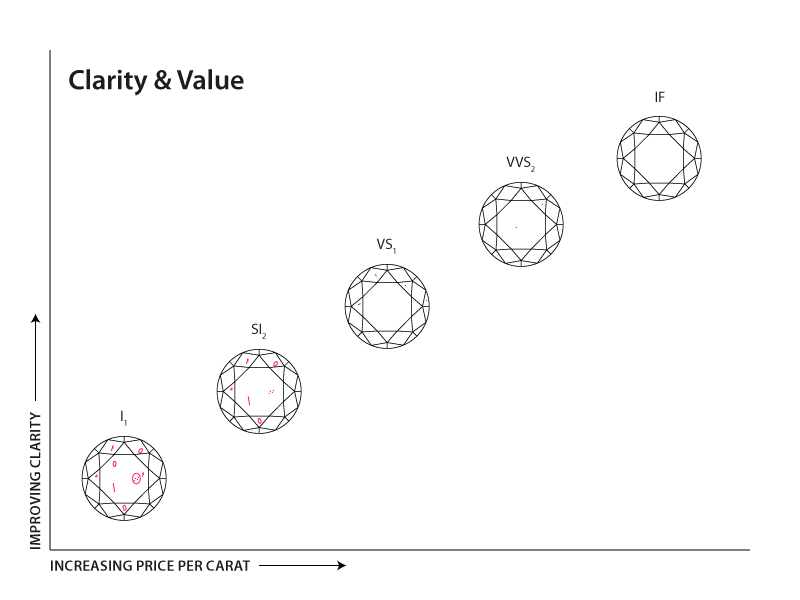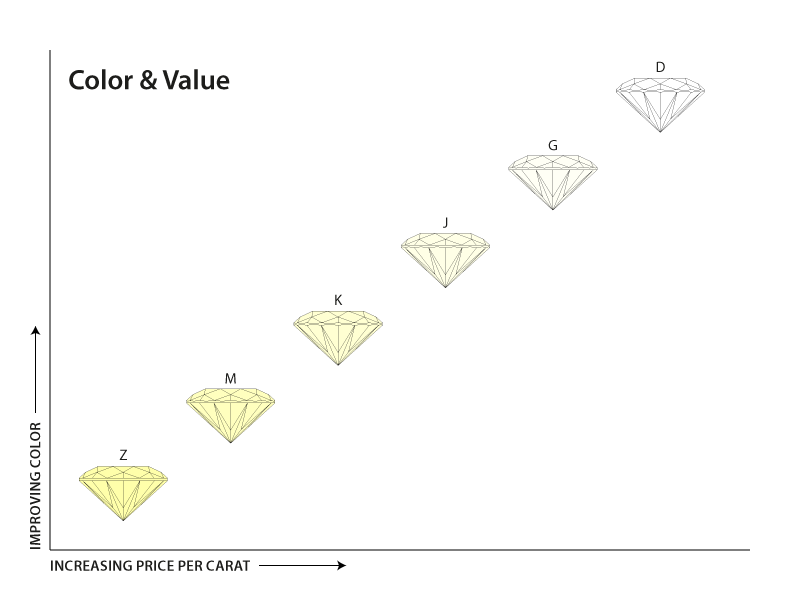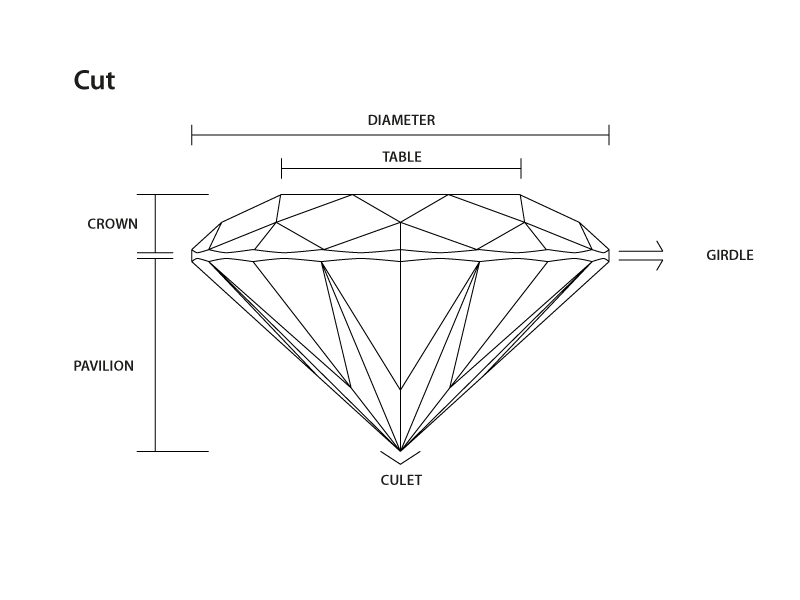Four C's

When shopping for a diamond online, no matter where you look, you'll find this term. But what does it really mean? It means that when evaluating a diamond’s quality and value, 4 main factors should be considered:
-
Diamond carat (weight)
-
Diamond clarity
-
Diamond color (both white and fancy color)
-
Diamond cut (finish/proportion)
These are known as the "4 Cs".
The 4 Cs provide industry-wide standards to evaluate a diamond's quality and therefore its market value.
While clarity sometimes is assumed to be the most important factor of the 4 Cs, color and cut are actually more influential when considering a diamond's form.
While a diamond cut is 'artificially' determined by those who handle the stone (and naturally affect its carat size value – according to its final form), its color and clarity are determined by nature and the subterranean forces (and time) which have created this most precious of all gemstones.
Diamond Carat
The first of the 4 Cs is diamond carat.
Carat is the weight unit used for all gemstone evaluation. One carat equals exactly 0.2 grams and is divided into 100 points (0.01 carat each), in which one carat equals 100 points. Therefore, each point weighs 2 milligrams.
The word carat originates with carob tree seeds, which were used for the weighing of precious stones on simple scales in ancient times due to their weight uniformity.
Remember! A diamond's carat is a measurement of its weight and not its size, as the form and cut of the diamond might affect its overall measurements (width, length, depth) making diamonds of similar carat weight sometimes appear different in size.
Also the term is not to be confused with Karat, used for determining the purity of gold.
What does it mean in terms of value?
In the diamond exchange trade, a diamond’s price is usually quoted in USD per carat. For instance a 2 carat fancy yellow diamond might be quoted at 6000$ per carat, making its overall price 12000$.
In both white diamonds and fancy color diamonds, the higher the carat weight, the higher the price per carat. That's mainly due to the fact that it's much rarer to recover large gem quality rough diamonds than small ones.
In rare fancy colors such as pink, blue and green a diamond's price per carat is significantly higher when it weighs over one carat because finding one of that weight and above is very rare.

Diamond Clarity
The second of the 4 Cs is diamond clarity.
A diamond's clarity is determined by the number, nature, location, size and color of its internal characteristics called "inclusions," and its surface features called "blemishes." These flaws, or effects, originate in the liquid magma (volcanic rock) within which the diamond was created.
A diamond's clarity is measured on a scale ranging from completely pure (flawless) to heavily included (I-3). The clarity of a diamond is graded by using 10X magnification under good lighting by an experienced grader. The final clarity grade is usually determined by how easily the inclusions and blemishes are seen by the grader.
The types of internal inclusions that affect a diamond's clarity include feathers (fractures that resemble feathers), clouds (internal crystals appearing like dust) or needles (inclusions that resemble tiny needles).
Typical external blemishes include chips (damage to a diamond's facet), bruising (caused by an external impact) or knots (caused by inclusions penetrating the diamond's surface).
Dark inclusions found in diamonds tend to have the greatest effect on a diamond's clarity grading, causing it to drop significantly. Lighter inclusions in both white and fancy colored diamonds are sometimes even transparent and undetected by the naked eye.
There's a key term, 'eye clean,' which is used to describe borderline
diamonds such as those graded with mediocre clarity as VS2 or SI1. When we state a diamond is 'eye clean,' it
means the diamond's inclusions cannot be detected by the naked human eye.

Diamond Color
The third of the 4 Cs is diamond color.
A diamond's color is a result of varying quantities of nitrogen and other trace elements present in all diamonds, displacing the carbon atoms within the crystal’s structure.
In traditional white diamonds, as a principle, the ideal situation is a diamond which is completely colorless. Yet, diamonds of vivid color, called Fancy Color Diamonds, are extremely valuable.
Increasing degrees of a diamond's body color are measured on a scale ranging from no color at all (D) to visible saturated color (Z). Beyond "Z" is the range where the diamond's color is rich, both in hue and in its distribution, and the diamond is then considered to be a fancy color diamond, which is graded on an intensity level between very light to fancy deep or fancy vivid. To learn more about intensity levels and fancy color diamonds read more here.
In essence, the process of diamond color grading is as follows. Diamonds of known color are used as comparison stones for color grading. Grading is done by comparing the diamond to be graded against these "master stones" under either artificial or natural daylight.
A machine called the "Colorimeter" can be used for color grading but there is no substitute for the trained human eye.

Diamond Cut
The fourth of the 4 Cs is diamond cut.
A diamond cut's grade describes the polished stone's degree of quality. The intensity of brilliance, luster and fire embodied in the diamond are revealed through the expert work of a skilled diamond cutter.
Ideal proportions, finish and symmetry of a cut are the cutter's goals, as well as the shape of the stone. The final shape of a polished diamond is divided into Round Brilliant Cut, which refers to a round shape, and Fancy Cuts, which refer to all other shapes.
A diamond's cut grade is not the same as its shape. Shape means the outward look of the diamond (such as round, square, oval, pear and so on). Cut grade refers to the reflective qualities of the diamond and some gemologists claim that this is the most important of the 4 Cs.
A stone’s cut quality grade ranges between an ideal cut to a poor cut.
The wrong proportions, meaning a poor cut, might cause the diamond to lose its brilliance, scintillation and fire and look like an imitation diamond.
You will see a cut grade only for traditional shapes such as Round Brilliant Cut and Emerald Cut. Other fancy shapes (such as pear, cushion, oval etc.) will have only polish and symmetry grades.
A diamond's polish grade refers to the degree of smoothness of the diamond’s outer facets, its surface.
A diamond's symmetry grade refers to not only the ratio between its width and its length, but also to many other relationships between various areas and facets of the polished diamond. It measures how well these faces align and intersect as this is crucial to the way light travels within the diamond.

Diamond Certification (the 5th c)
Wait a minute...weren't there only 4cs?
That's correct, but in recent years, it has become very popular to refer to diamond certification as a key attribute. That is mainly due to the strong effect it has on a diamond’s market value. Diamonds with GIA certificates are almost always more expensive than diamonds with no certificate at all, because it is easier to find a buyer for GIA graded stones. Therefore, they have more liquidity as an asset.
On the other hand, people who are already trained and knowledgeable about diamonds and trust themselves to identify a fake diamond when seeing one can save a lot of money by buying ungraded diamonds from a trusted supplier. Trusted suppliers should be official and certified members of the diamond industry, not just someone you meet on the street...
To read more about diamond certification and the various leading labs go to this article.

- Contact
- Contact Us
- B2B
- Our Diamonds |
- Jewelry |
- Blue Diamonds |
- Orange Diamonds |
- Pink Diamonds |
- Yellow Diamonds |
- Purple Diamonds |
- Green Diamonds |
- Chameleon Diamonds |
- Gray Diamonds |
- Black Diamonds |
- White Diamonds |
- Violet Diamonds |
- Red Diamonds |
- Champagne Diamonds |
- Diamond Pairs |
- Diamond Layouts |
- Diamond Rings |
- Diamond Earrings |
- Diamond Bracelets |
- Diamond Necklace |
- Diamond Pendants |
- Colorless Diamonds |
- Natural Gemstones |
- Argyle Pink Diamonds |
- Zimmi Yellow Diamonds













 Powered by
Powered by